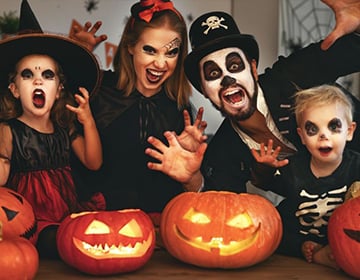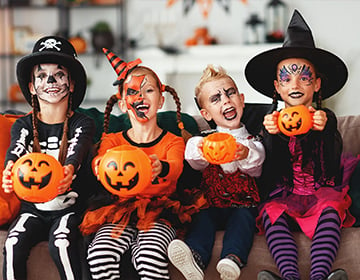In Spain, Halloween celebrations last for 3 days: the Day of the Witches, All Saints Day, and the Day of the Dead. Each autonomous community in Spain has its own traditions and events on Halloween.
Halloween celebrations may differ due to the cultural context. People often wonder “Do they celebrate Halloween in Spain?” The answer is: Yes. It is a well-known fact that if there is something to celebrate, Spaniards know how to do it better than anyone.
We have prepared a perfect guide to celebrate Halloween as a true Spaniard. If you are wondering how do they celebrate Halloween in Spain, here are some facts about Halloween in Spain.
Halloween is Celebrated for 3 Days in Spain
 Don’t be surprised if you see the zombies walking around even a few days later than the actual Halloween. The whole Halloween concept has some differences in comparison to the US customs.
Don’t be surprised if you see the zombies walking around even a few days later than the actual Halloween. The whole Halloween concept has some differences in comparison to the US customs.
Halloween in Spain begins with Dia de las Brujas or Day of the Witches in English. The first day of the spooky season is on the same day as the other countries, October 31st.
The second part of the festival continues on the next day, November 1st. The next day, Día de Todos Los Santos is All Saints Day. It is the most important event of the trio for Spaniards.
And then we have the last day on November 2nd: Dia de Los Muertos, the Day of the Dead. The traditions of Dia de Los Muertos are believed to be inherited from the Mexican culture.
Spanish Halloween is Celebrated Differently in Each Community
Halloween traditions in Spain show diversity between communities. Each region of Spain has its own cultural structure. These differences also affect communal activities such as celebrations, ceremonies, and rituals.
For example; Halloween traditions in Northern Spain are deeply affected by the Celtic culture. Mainly around Galicia, the holiday is celebrated more enthusiastically and in a traditional way.
The first day, October 31st is called “Noite dos Calacús” in Galicia. It means “The Night of the Pumpkins”. Some Galicians dress up and tell ghost stories to each other. In some places they burn bonfires and perform mystic rituals, mainly containing Celtic practices.
Sometimes they prepare a drink called “Queimada” with rituals including chanting spells to be protected from evil spirits. Queimada is served as being set on a fire. The drink’s most special feature is its blue flames and preparation ritual.
In Alicante, celebrations take place in a more contemporary way in recent years because of the multi-national demographic context of the region. Many foreigners choose to live in Alicante because of its captivating atmosphere.
With its cosmopolitan demography, Alicante has become a global province with people from all over the world. During the Halloween festivals in Spain Alicante, people dress up and participate in activities and costume parties.
There is also a local fair in Concentaina, nearly 60 km from the Alicante center. Feria de Todos Los Santos is one of the oldest fairs held in Spain. In this joyous fair, people dress up as creatures and movie characters.
Also, some local and international dishes ornated with Halloween concepts are offered at this fair. You can buy handmade souvenirs and enjoy the lively ambiance of the amusement park.
Prepare yourself for a battle and be aware of the zombies in Málaga! Halloween in Spain Málaga may seem like a scene from the Resident Evil movies.
The most famous tradition there is the most crowded event of the spooky season: the Zombie March. Despite its name, it may seem like a Champions League because you may also come across vampires, mummies, witches, goblins, and other creatures.
The Celtic Practices Still Exist Today
When we look at the history of Halloween in Spain, we will come across the Celtic practices inherited from the Irish. The origins of this holiday are traced back to celebrations of Samhain.
Samhain was a Gaelic festival and it was transformed into All Hallow’s Eve with Christianity. Eventually, it started to be announced as “Halloween” by time.
Samhain used to take place on the night of October 31st, the same as the Halloween we know today. The Celtic practices and rituals are more common among Halloween traditions in Northern Spain. Lately, the celebrations have become more American-like but Celtic customs still preserve their importance in folkloric and spiritual contexts.
 Truco o Trato: We Want Halloween!
Truco o Trato: We Want Halloween!
Did you know that the “Trick or Treat” practice also comes from the local folklore of Scotland and Ireland? The “guising” custom was mainly linked to “disguising oneself” as some mythological being.
People often would go from door to door, perform small skits or recite poetry in exchange for food and drink. This tradition has become a well-known “trick or treat” over time.
In Spain, the famous tradition of “trick or treat” is not as common as in the USA. Trick or Treat is an exciting activity for children around the world but it is an optional activity in Spain. Children mostly dress up as a movie character or a creature and then attend some Halloween-themed in-school activities.
However, some families prefer trick-or-treating for their children. The Spanish definition of this activity is Truco o Trato. Some kids say “Queremos Halloween” which means “We Want Halloween” instead of its original saying.
Cemeteries are Ornated as English Gardens
Halloween like traditions in Spain is pretty common among all residents during the spooky season. However, this 3-day festival has a deeper meaning for locals. Spaniards mostly celebrate this day to honouring the dead with mystic rituals and practices.
The “Day of the dead” on November 2nd is a solemn holiday in Spain. All Spaniards commemorate their decedents on these days. People often visit cemeteries to bring flowers to the deceased family members.
During these days, graves of the loved ones would be adorned with candles and all kinds of flowers. All cemeteries smell like English gardens during Halloween in Spain.
In some places such as Barcelona, people plan night tours in cemeteries to keep up with the Halloween spirit. It is difficult to resist to fell under the spell of these gorgeous cemeteries lit by hundreds of candles under the moonlight.
Let’s Talk About the Traditional Dishes!
When we mention a festival, we’ve got to talk about traditional meals. During the fairs and festivals held throughout the country, some dishes such as Huesos de Santo stand out as must-serve!
.jpg) Husesos de Santo, or in another saying “The Saint’s Bones” is the most famous dish of the season. The Husesos de Santo is made with marzipan paste and sweet yolk filling. These bone-shaped treats are generally served during “All Saints’ Day”.
Husesos de Santo, or in another saying “The Saint’s Bones” is the most famous dish of the season. The Husesos de Santo is made with marzipan paste and sweet yolk filling. These bone-shaped treats are generally served during “All Saints’ Day”.
La Castanyada is the roasted chestnut that is also famous to serve during the Halloween season. It is believed that the chestnuts were offered to the bell-ringing workers on the first day, October 31st.
Local dishes, sweet potatoes, almond sweets, and sweet wine is served along with the roasted chestnuts in feasts and festivals.
Experience it Yourself!
Life in Spain is pretty colorful; even in this darkest and spookiest season of the year. Book your flight to experience it yourself today. Buy your dream home and enjoy the privileges of living in Spain for a lifetime!


